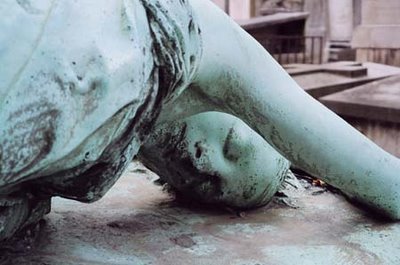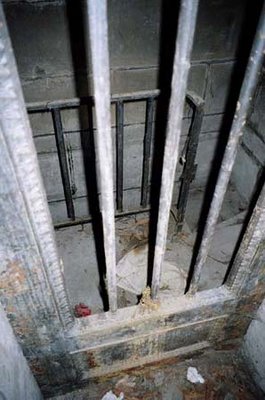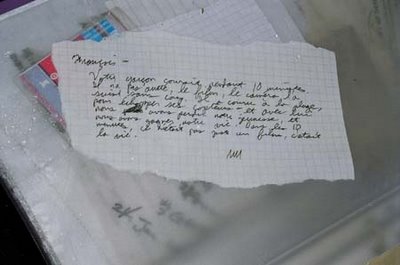Day 2, Le Cimetière Montmartre, continued
I consider heading back to the beginning of where the tour book indicates; maybe if I start over again and follow the route exactly I'll have a better chance of finding her. Then I catch a glimpse of green to my left. I check the street signs and note that I’m near the 22nd division. On the map, only #2 is labeled in the 22nd division, but #2 is not listed in the index for that map (the list goes from #1 to #3... I found a bug in the tour book!).
As I head to the left, I begin to know it’s her. I think of the scene in the Seven Samurai where we first see the daughter of farmer Manzo as she prays that he not cut her hair. We are looking at her from behind, as she washes her long, beautiful hair. As I approach, I can’t believe how small she is. But that’s her.

I reach out my hand and run it along her upper arm, squeezing to make sure she isn’t flesh. Her peasant dress is cinched in the back and her hair is tied up loosely, falling on the ground below her. Her fingers are interlocked, so well defined that I can make out her cuticles.

Toward the back, the curve of her hips as her legs curl up under her and her knees are bent, I want to touch her waist, again to see if it’s really made of metal. Her bare feet show lines and calluses, her nightgown strewn beside them. Water is collecting behind her knees and I want to soak it up, to clean off the black dirt accumulating in the folds of her dress and on her face.

I don’t want to leave. I take several pictures, and finally decide that I’m going to come back before I leave Paris to look at her some more.

 I criss-cross the cemetery, finding the court-jester Nijinsky, Foucault “of pendulum fame,” and one tomb with a staircase going down at least twenty feet. The door was locked or I would have followed it.
I criss-cross the cemetery, finding the court-jester Nijinsky, Foucault “of pendulum fame,” and one tomb with a staircase going down at least twenty feet. The door was locked or I would have followed it.
Some new graves have actual photographs on them, which somehow seems less important than a sculpture. Accuracy of detail makes me appreciate the death less I think. You don’t plan a photograph to show you in your death-pose; photographs show a particular context, a situational emotion. The sculpture is meant to cry out against the heavens and denounce the Creator who takes everything He gives.
The tour book shows a “superb bronze of a violated young woman, her eyes closed, face tense, lips forming a silent cry against the Heavens”, and I spend nearly as much time with her as I did with the prostrate girl. But somehow she doesn’t provoke the same emotional reaction in me. With the Violated Young Woman, I more appreciate the sculpture than pity the person. I’m not even so sure how violated she looks; I’d sooner call it sadness or sincerity.

On the way out I remember Truffaut. I check several maps and manage to find his jet-black marble grave, saying only “Francois Truffaut, 1932-1984” (635-16A).
 There is a pink 3-ring binder laying on the grave. Without touching it I read the front cover. It’s from a documentary filmmaker, gathering remembrances from people who visit Truffaut’s grave. He wants people to write notes telling Truffaut what they appreciate about him, so I do.
There is a pink 3-ring binder laying on the grave. Without touching it I read the front cover. It’s from a documentary filmmaker, gathering remembrances from people who visit Truffaut’s grave. He wants people to write notes telling Truffaut what they appreciate about him, so I do.

I told him about how striking it was that his boy ran for 10 minutes solid, without cutting, to the beach. He lost his freedom but gained his life. I hope the note is appreciated. Frankly I think there’s something great about leaving something like that in Paris. I normally don’t like to pull pages or tear things out of my notebook, but this is special, and I’ll always think about it when I pull out Leo IV and see it missing.
I take a different way out from how I came in and this allows me to have a word or two with some mourners. They’re charming people and they’re very polite. One grave I pass is covered with fresh-cut flowers and plants. They haven’t even been there for more than a couple hours, I think. A couple approaches, probably mid-40s, maybe younger. They are carrying a basket with purple flowers and greenery, bearing a ribbon that says “à mon fils”. The other flowers on the grave say “à mon neveu” or “à mon petit fils”. The couple move past me and place the flowers on the ground in front of the grave, then they stand motionless. I get the idea to take a picture, but I can’t bring myself to do it.
As I walk to the front of the cemetery my feet move slowly. I turn back every few minutes to see the couple standing there. They don’t look like they’re breathing. The man is holding the woman’s purse in his right hand. I near the front and before they are out of sight I turn again. They haven’t moved. They are almost difficult to spot next to the bust of Berlioz, the cherub dancing next to the gated and broken tomb, and the memory of La Douleur. I feel a tear in my eye.
Then I head back to civilization, to continue the tour of the Sacred and the Profane.
Labels: paris




0 Comments:
Post a Comment
<< Home